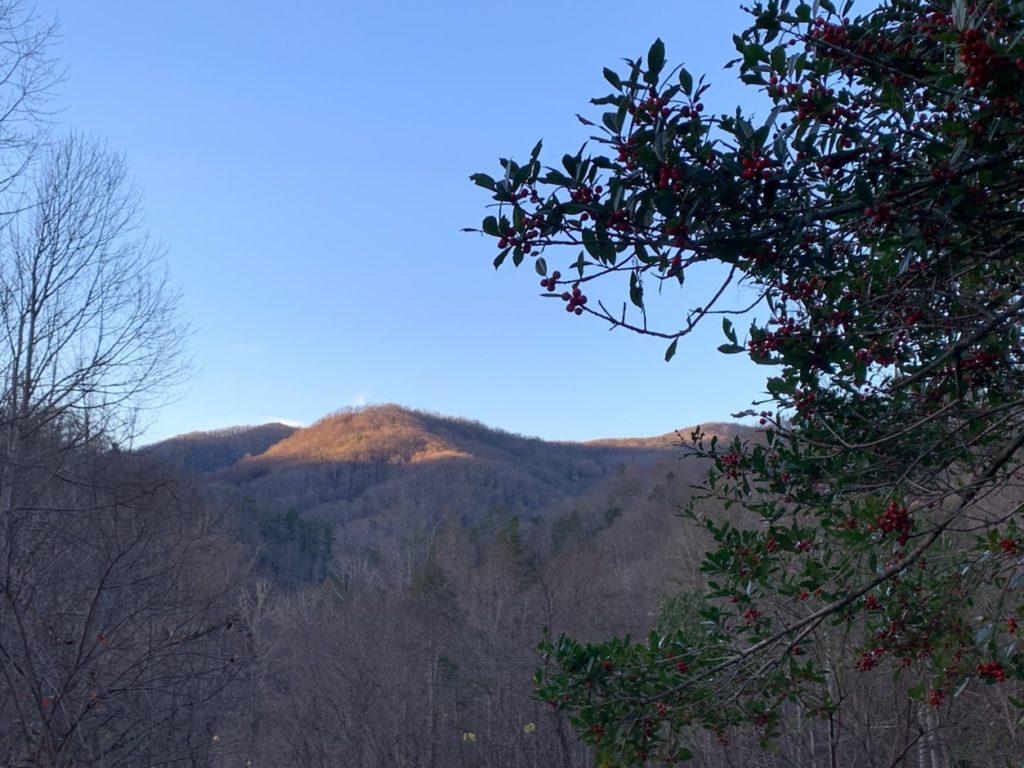The Forest in Winter

Photo by Mattie Decker
“Come,” said the trees. “Come, and be still with me.”
Dr. Mattie Decker shares her musings of the forest. Join her at a forest bathing session.
It’s the most amazing thing. To be walking on a path you’ve known so well during the spring and summer and in autumn– and now…to discover suddenly such new vision and appearance everywhere! So much is being revealed to you that until now, has been unseen during the rest of the year! For example, here in the Hickory Nut Gorge there is such silence and stillness. The other day I saw a large white oak leaf on the ground that called me over to take a look. It seemed so large and beautiful, the shape of a tree, itself. Details unnoticed before are now everywhere. I can clearly see the Rocky Broad river moving below for the first time since a year ago, and the peaks of stony cliffs stand out clearly above me. I will climb up there again this winter as I did last year while everything is asleep inside some den or cave and I can climb easily, step by careful step, to the summit. I remember the silence and the rare company I felt about me. I also found a smooth ledge where I lay down for a little nap. There is a pristine peace and calm, it seems, throughout the world.
I hope to share these winter walks of what we call “forest bathing”, even as the trees are bare and seemingly lifeless. Anyone who stands near one of these old growth trees or the young ones, the little hemlock and pine, the birch, the oak and the holly, in what I call the “sweet little forest” knows better. There is much life within these trunks and in these limbs as energy is being generated, and stored for the spring new growth.
And what about us in winter? Shall we listen and take the forest’s advice to slow down, to quieten and to listen? What if this is what we should do also, in our lives. In our world, even with Covid restrictions, we can be so over-stimulated with screens and channels and fast-paced programs and digital meetings one after another, we may have forgotten some essential truths. I welcome this Wintering and am hopeful this can become a time of renewal for all of us.
In her new book, Wintering: The Power of Rest and Retreat in Difficult Times, Katherine May writes, “Wintering is a way to get through tough times by chilling, hibernating, healing, re-grouping. Doing these deeply unfashionable things — slowing down, letting your spare time expand, getting enough sleep, resting — is a radical act now, but it is essential.”
I feel radical myself some days, walking in the forest and many times simply resting in my “sit spot” near an ancient tree or on a rock by the river. It is medicine. It is sanity. I give thanks for the training I have been lucky to have with ANFT (Association of Nature and Forest Therapy) and to know the science back of what perhaps our grandparents and great-grandparents may have known—that to spend time in nature is to know calm and a return to oneself.
During the Forest Bathing walks, I see the unmistakable results of relaxation and sense of well-being emerge in participants, each, in unique ways. We say “everything is welcome here” and while some share openly, others remain silent and enjoy simply being in nature as they slow down and notice, pay attention, to their senses and the world around them. It’s the relationship I witness awakening—realizing we are not an observer of nature, but are ourselves, nature. Restoring our relationship with the natural world is reciprocal, as writer Robin Wall Kimmerer suggests here:
Knowing that you love the earth changes you, activates you to defend and protect and celebrate. But when you feel that the earth loves you in return, that feeling transforms the relationship from a one-way street into a sacred bond. (Braiding Sweetgrass: Indigenous Wisdom, Scientific Knowledge, and the Teachings of Plants (2013).
I see the guided forest bathing walks as a beginning. The more one becomes aware, this experience can occur anytime, and anywhere with nature. In our own backyard, or during time spent with a pet, or simply gazing out a window at a tree! Time spent outdoors during Winter walks may require more careful planning—dressing with enough warmth with hat, gloves or mittens and the right kind of shoes—and we may find it worth the trouble as we come to know ourselves, and the natural world in surprising, new ways.